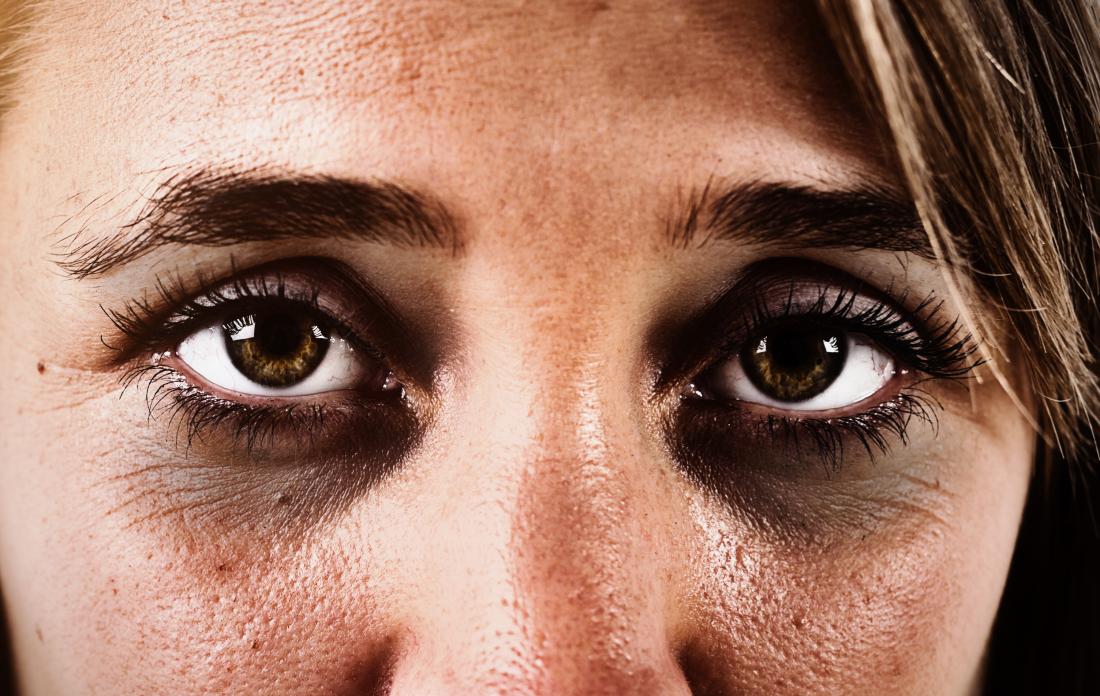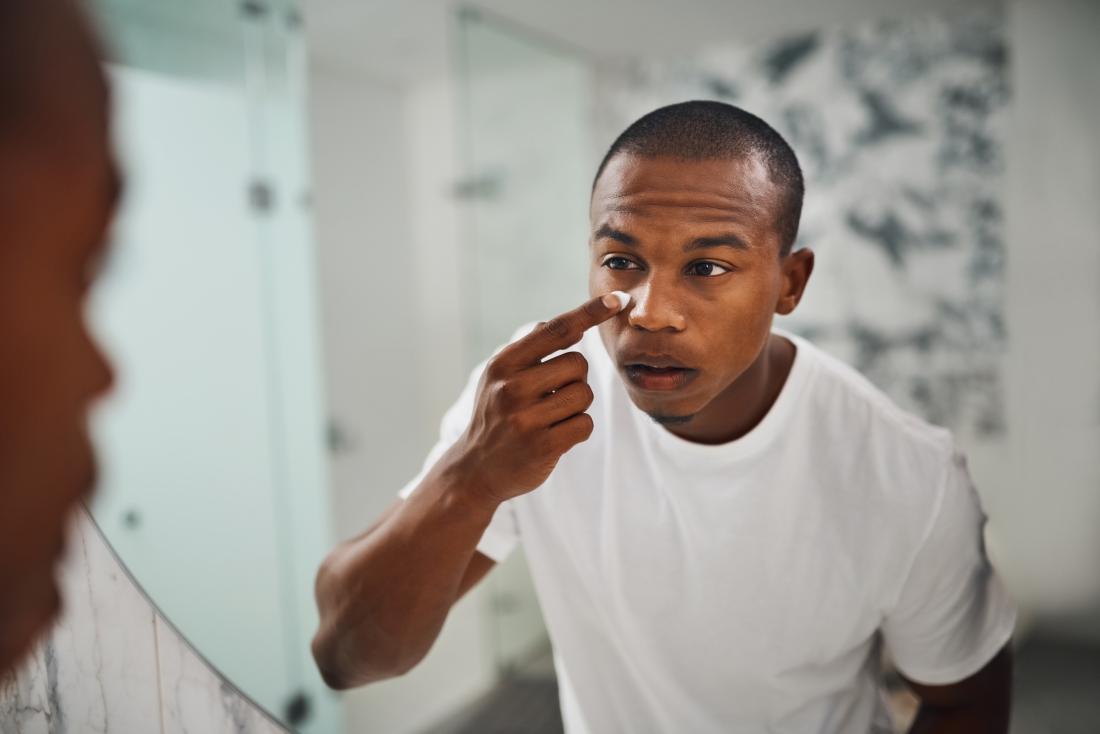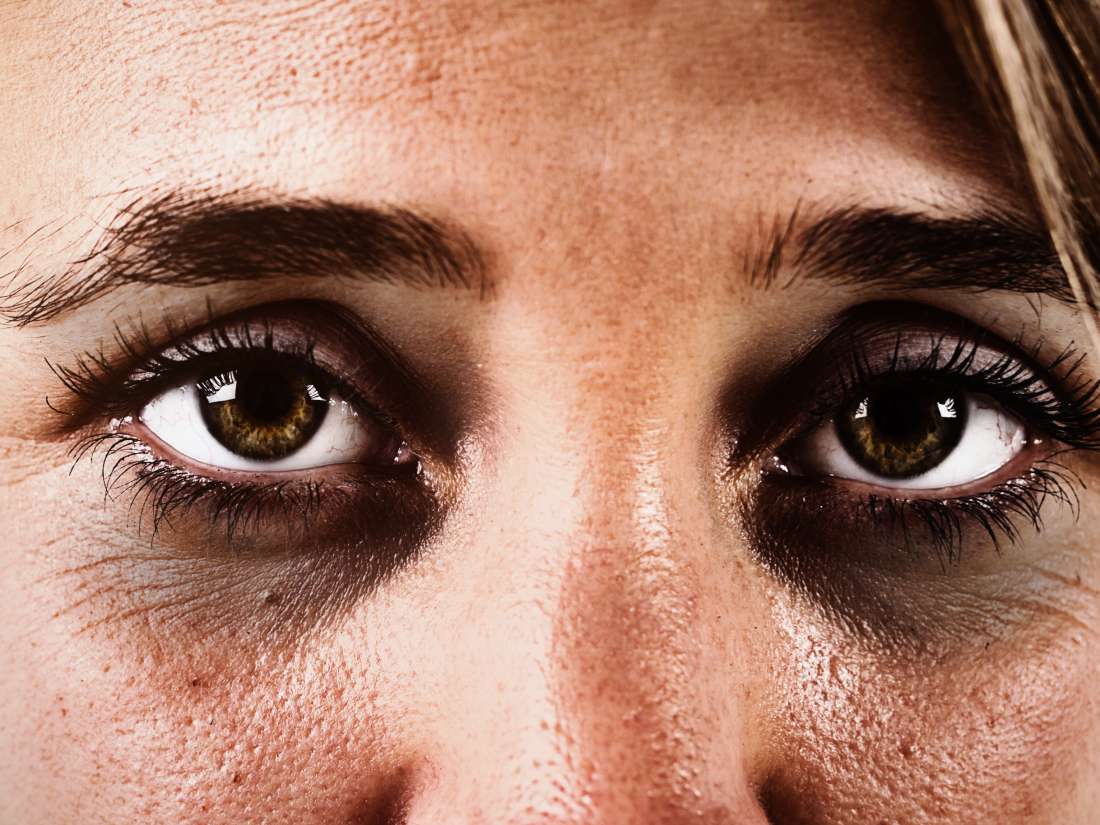Dark circles under the eyes may look purple or blue to dark brown or black, depending on skin color.
These circles are rarely a cause for concern, but people may wish to reduce their appearance for cosmetic reasons.
In some cases, dark circles under the eyes can indicate a need for lifestyle changes, such as improvements to sleep habits or diet.
Causes and risk factors

Poor sleep may cause dark circles under the eyes.
The area under the eyes can appear darker due to constricted blood vessels causing hyperpigmentation, or from thinning of the skin around the eyes.
All causes of dark circles under the eyes include:
- lack of sleep or poor sleeping habits
- allergies, including hay fever
- hyperpigmentation, which happens when the body produces more melanin
- reduced levels of fatty tissue around the eyes
- thinning skin under the eyes
- anemia from iron deficiency
- overexposure to sunlight
- frequent rubbing of the eyes
- aging
- smoking
- inherited genes
- thyroid conditions
- dehydration
- dermatitis
- eye drop treatment for glaucoma, such as bimatoprost
There are some risk factors for dark circles under the eyes, such as:
Older age: Loss of fatty tissue and thinning of the skin around the eyes are part of the aging process. These changes can make dark circles appear more defined in older adults. A tear trough is the hollow under the eyes, which can cause dark circles and is related to aging.
Nonwhite ethnicity: Dark circles are more common in people with darker skin tones, and they affect people of color more than white people. This risk factor is thought to be due to changes in pigmentation.
Genetics: Dark circles can be hereditary. Research has found that if someone has dark circles under their eyes, these also appear in some other family members.
Home remedies

Skin care products that contain antioxidants may help reduce the appearance of dark circles.
People may be able to reduce the appearance of dark circles under the eyes with simple home remedies.
Although some of these remedies are not scientifically proven, they may be worth trying as many are inexpensive and produce no side effects.
More sleep
People can make sure they are getting enough quality sleep each night to help reduce or prevent dark circles. Raising the head up on extra pillows may help reduce dark circles and swelling around the eyes.
Cucumber
Applying cucumber slices to the eyes may soothe tired eyes and reduce swelling. The high water and vitamin C content of cucumber may help to nourish and moisturize the skin. Cucumber also contains silica, which is essential for healthy tissue.
Cold compress
Applying a cold compress to the eyes can constrict blood vessels and reduce the appearance of dark circles.
Tea bags
Tea bags may help lessen dark circles and puffiness under the eyes. Caffeine has antioxidant properties and stimulates blood circulation around the eyes.
A person can boil two tea bags in water before letting them cool, then resting them on each eye. Putting boiled tea bags in the fridge first can add a cooling effect for the eyes. People can use black, green, or herbal tea bags.
Facials
Poor circulation around the eyes can cause the appearance of dark circles. Gentle massage around the eye area through a facial can help to improve circulation.
Antioxidant skincare products
Face creams and under-the-eye products that contain antioxidants may help to reduce the appearance of dark circles. Vitamins E and C are antioxidants that may help treat dark circles.
Makeup
Although makeup will not alter dark circles, people may want to use an under-the-eye concealer for cosmetic purposes.
Medical treatments
If home remedies do not get rid of dark circles under the eyes, a person can see their doctor or dermatologist for advice on medical treatment.
Medical treatment options include:
Topical creams
Bleaching creams can help to reduce hyperpigmentation. These might include:
- hydroquinone
- tretinoin
- a combination of both
People may need to use hydroquinone for at least 3 months to see an effect.
Kojic acid
Anecdotal reports state kojic acid is effective in treating dark circles. Kojic acid is a natural product that comes from two species of fungi. However, it is important to know that side effects of kojic acid can include contact dermatitis and reddening of the skin.
Azelaic acid
People may use azelaic acid to treat hyperpigmentation under the eyes, and it is safe to use over long periods.
Topical vitamin C
A study looked at the effects of 10% vitamin C lotion in the treatment of dark circles, over 6 months. The lotion was effective in lightening darkness under the eyes.
Chemical peels
Chemical peels, using alpha hydroxy acids, such as glycolic acid, can help to lighten hyperpigmentation under the eyes.
People may also use chemical peels in combination with topical creams for better effect.
Lasers
Laser therapy can be an effective treatment for dark circles. Less invasive laser procedures, such as pulsed dye or diode lasers, may lessen the risk of scarring or other potential side effects.
Fillers
If thinning of the skin or loss of fatty tissue is causing dark circles under the eyes, fillers may be a potential option. People can have injections of platelet rich plasma or hyaluronic acid gel into the area under the eye.
Surgery
A type of surgery called blepharoplasty can get rid of dark circles that are due to deposits of fat or extra skin around the eye area.
The area under the eye is extremely delicate, and people should always discuss possible side effects. They must also ensure that only a certified dermatologist carries out any medical procedures for this area.
If people are taking certain drugs, such as bimatoprost for glaucoma, dark circles will disappear after they stop using the medication.
Prevention

Wearing UV protection sunglasses can help prevent dark circles forming under the eyes.
People can help prevent the appearance of dark circles by addressing lifestyle factors.
- Getting enough sleep and reduce stress: Researchers found that stress increased the appearance of dark circles, while rest and healthy lifestyle habits decreased discoloration.
- Protecting the eyes from the sun: Wearing UV protection sunglasses that cover around the eyes and wearing sunscreen around the eyes can help to prevent or reduce dark circles.
- Stopping smoking and reduce alcohol consumption: Smoking and excessive alcohol consumption can speed up the aging process of the body and may increase the risk of dark circles.
Summary
Dark circles can affect anyone of any age and ethnicity for a variety of reasons. Genetics, aging, and lifestyle factors all play a part in the development of dark circles. People may also find that allergies, nutrient deficiencies, or underlying health conditions can cause dark circles.
Home remedies can help to treat dark circles. Maintaining a healthy lifestyle with quality sleep, balanced diet, and proper hydration may all help prevent dark circles.
If people have concerns about the appearance of dark circles, they can see their doctor or dermatologist for treatment options and to check for any underlying health conditions.
